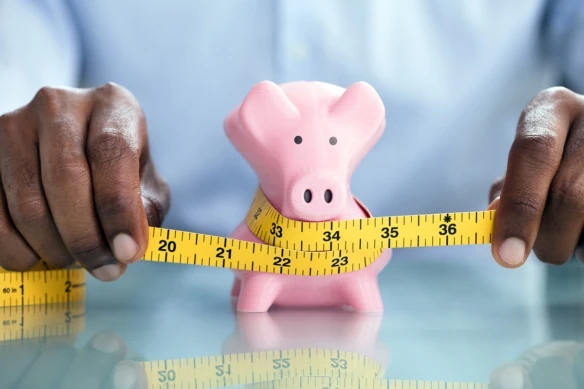The market’s hopes for at least one 2024 interest-rate cut received two shots in the arm on Wednesday, as April’s headline consumer price index (CPI) print was slightly lower than expectations and last month’s retail sales came in flat.

The U.S. Department of Labor said on Wednesday that April’s consumer price index, which measures the change in prices on a variety of consumer goods and services, was 0.3% higher from March on a seasonally adjusted basis. That was slightly below the 0.4% growth expected from Dow Jones-polled economists.
Inflation’s year-over-year change of 3.4%, meanwhile, was both on par with estimates and the previous month’s YoY reading.
Related: The 13 Best Mutual Funds You Can Buy
“Core” CPI—a measurement that backs out food and energy costs, which are more volatile than the other costs tracked by the Labor Department—also came in as expected on a month-over-month basis (+0.3%). The year-over-year reading of 3.6% was also on par with predictions and was the lowest print in three years.
Here’s a quick look at Wednesday’s key figures:
- MoM CPI: +0.3% (vs. +0.4% est.)
- YoY CPI: +3.4% (vs. +3.4% est.)
- MoM Core CPI: +0.3% (vs. +0.3% est.)
- YoY Core CPI: +3.6% (vs. +3.6% est.)
Among the most noteworthy gains in April were motor vehicle insurance (+1.8% MoM) and apparel (+1.2%), though the former marked a slowdown from a 2.6% rise in prices in March. Energy was up 1.1% as well, thanks to steep increases in gasoline (+2.8%). Declining costs last month included utility gas service (-2.9%), used cars and trucks (-1.4%), and airline fares (-0.8%).
“This morning’s in-line CPI print should assuage near-term fears that inflation has been re-accelerating after string of hotter prints in the first quarter,” says Josh Jamner, Investment Strategy Analyst at ClearBridge Investments. “While the Fed will want to see further data showing that inflation has resumed its drift lower before gaining confidence that they can lower interest rates, today’s print should begin to shift the narrative back toward ‘when’ the Fed will cut in 2024 rather than ‘if’ they will cut.”
Related: 9 Monthly Dividend Stocks for Frequent, Regular Income
A couple other reports out Wednesday also raised hopes for an eventual rate cut on Wednesday.
The Commerce Department reported that retail sales were flat in April, slowing from March’s 0.6% month-over-month reading. The print was also slightly lower than analysts’ estimates for a 0.4% improvement.
And the New York Federal Reserve’s Empire State Index, a regional gauge of industrial activity, remained in the contraction zone. The index reading declined from -14.3 in April to -15.6 in May, well below expectations of -9.0 and signaling that activity was shrinking at a slightly quicker pace.
“Shelter didn’t ease as hoped, but there was improvement in transportation and healthcare. The number wasn’t perfect, but we’re staggering toward lower inflation,” says David Russell, Global Head of Market Strategy at TradeStation. “Weaker data on retail sales and the Empire Index also suggest growth is slowing, which keeps rate cuts on the table. It was a trifecta of dovish news.”
More Pros’ Takes on April CPI
Here, we outline more thoughts from the experts on what April’s CPI numbers mean for consumers, markets, the Federal Reserve’s future actions, and more:
“With Chair Powell and the FOMC continuing to emphasize data dependence, we think this print provides a starting point for them to start thinking about cutting rates later this year. They will need to see a few weaker than expected CPI and PCE prints to get the confidence that they are looking for in order to start the cutting cycle. Going forward, the appropriate timing and path of policy rates remains very much dependent on the trend in data, not just a single print. We’ll be looking closely at future data to determine whether April’s inflation data bucks the recent trend (higher than expected price pressures) or if it’s a move in the right direction for the Fed’s target.
“Considering this CPI print and recent economic data, we think the Fed will begin to cut rates in the fall of this year. Stickier inflation has pushed the market towards pricing in about two cuts, which is in line with our view.”
—Gargi Chaudhuri, Chief Investment and Portfolio Strategist, Americas, BlackRock
The Best Dividend Stocks: 10 Pro-Grade Income Picks
“There are a lot of things that investors could worry about, but inflation isn’t among them. The Fed has made progress towards the 2% goal, and the current inflation reading is not really worrisome. This probably means that the Fed probably keeps rates higher for longer and that is fine.
“We continue to believe that the Fed moves when there is clear evidence that inflation is below 3% and moving to 2% or the economy looks to be stalling out. Neither is true with CPI at 3.4% and retail sales growth at 3%. This should be welcome news to investors. In the 1980s and 1990s, real interest rates were north of 2%. Those were good decades for businesses and investors. The CPI number lines up just fine. An economy with decent growth and 2%-3% real rates seems like walking on sunshine.”
—Scott Helfstein, SVP, Head of Investment Strategy, Global X
“The combination of an in-line CPI and retail sales that missed expectations largely due to revisions lower for March’s very strong numbers is rather market-friendly, with the disinflationary process looking to reassert itself while the consumer shows muted but positive spending growth. Simply put, today’s data looks like the soft landing is continuing to play out, which should help provide some stability for equity markets that have seen a fair bit of volatility over the past month as fears of a more inflationary ‘no landing’ took hold.”
—Josh Jamner, Investment Strategy Analyst, ClearBridge Investments
“The April CPI report was much more encouraging than the prior three reports, with a lot of key categories moving in the right direction. We’re continuing to see easing food prices, as well as deflation in commodities outside food and energy. Energy prices should also ease as we go forward given the recent fall in oil and gasoline prices. Even on the services side, we saw some easing in auto insurance and shelter inflation, while prices for airfares fell.”
—Sonu Varghese, Global Macro Strategist, Carson Group
“Sticky services inflation may be starting to get unstuck. Prices for core services excluding shelter grew 0.2% in April, which is the lowest print so far in 2024. This portion of the goods/services basket that make up the CPI has remained stubbornly high, but this a tenuous sign it’s now on the move lower.
“From the Fed’s perspective, today’s CPI report is a step in the right direction, but they will need to see several of those steps strung together before getting too excited about imminent rate cuts. It does alleviate some concerns that they may not cut at all this year, but it does not yet put rate cuts on the table immediately. End of summer/fall remains the most likely timeline for the start of the Fed’s rate cut program, though the next few CPI reports will be closely parsed to determine if that timeline remains feasible.”
—Jason Pride, Chief of Investment Strategy & Research, Glenmede
“The market is now pricing in 2 cuts for 2024; as an average for the range of potential outcomes, two cuts in 2024 is quite reasonable. However, we believe that not enough cuts are priced for 2025 and 2026. The December 2026 futures contracts suggest that Fed Funds will still be around 3.8%. We believe the Fed will bring the Fed Funds rate meaningfully below this level either because inflation will ease back towards its target into a softish landing or because a weaker economy will bring down inflation below target.”
—Greg Wilensky, Head of US Fixed Income, Janus Henderson Investors







